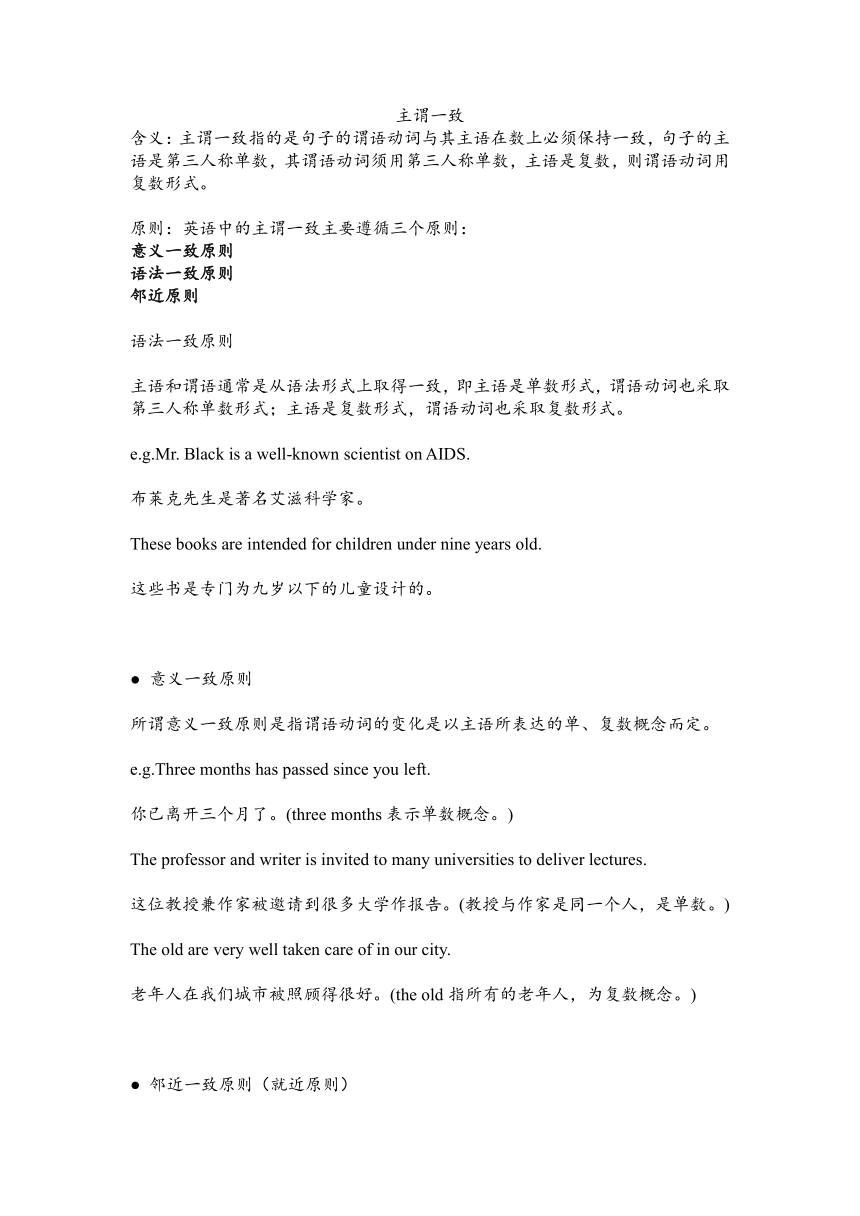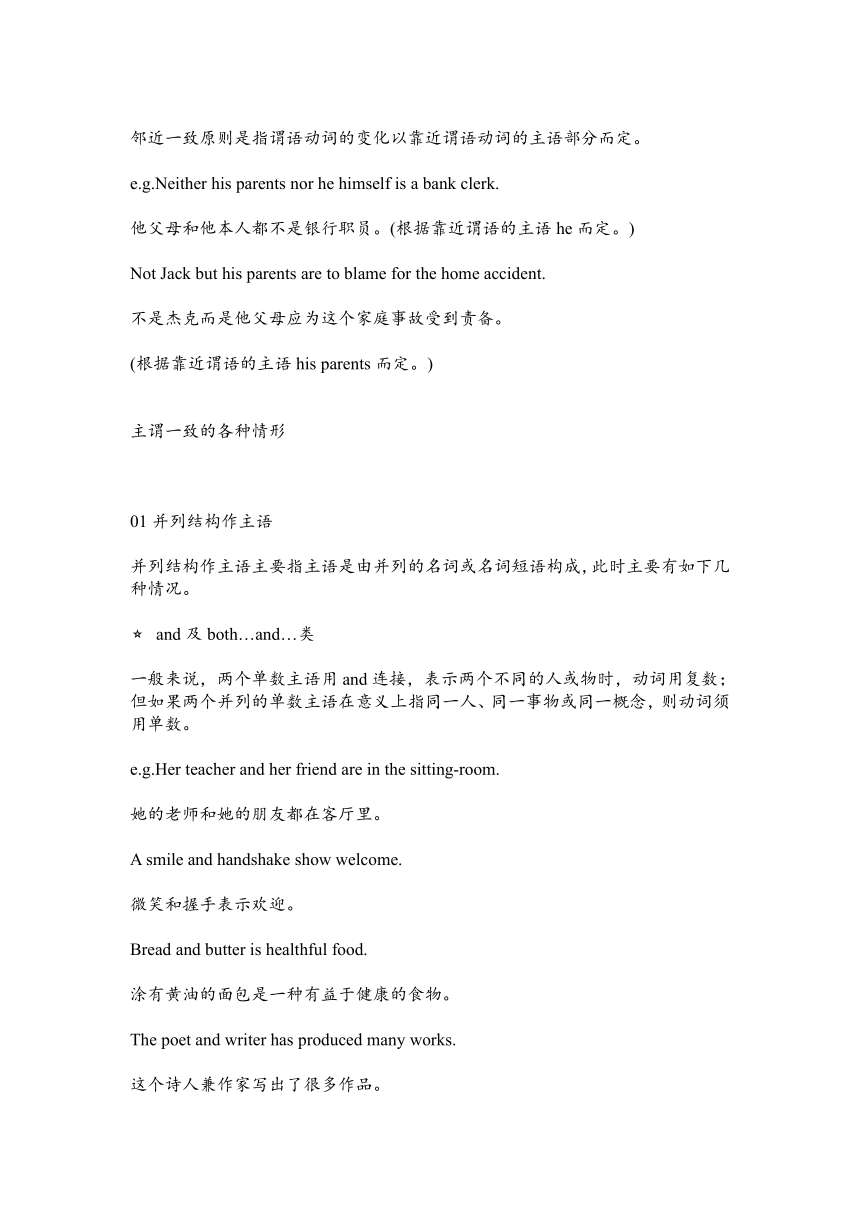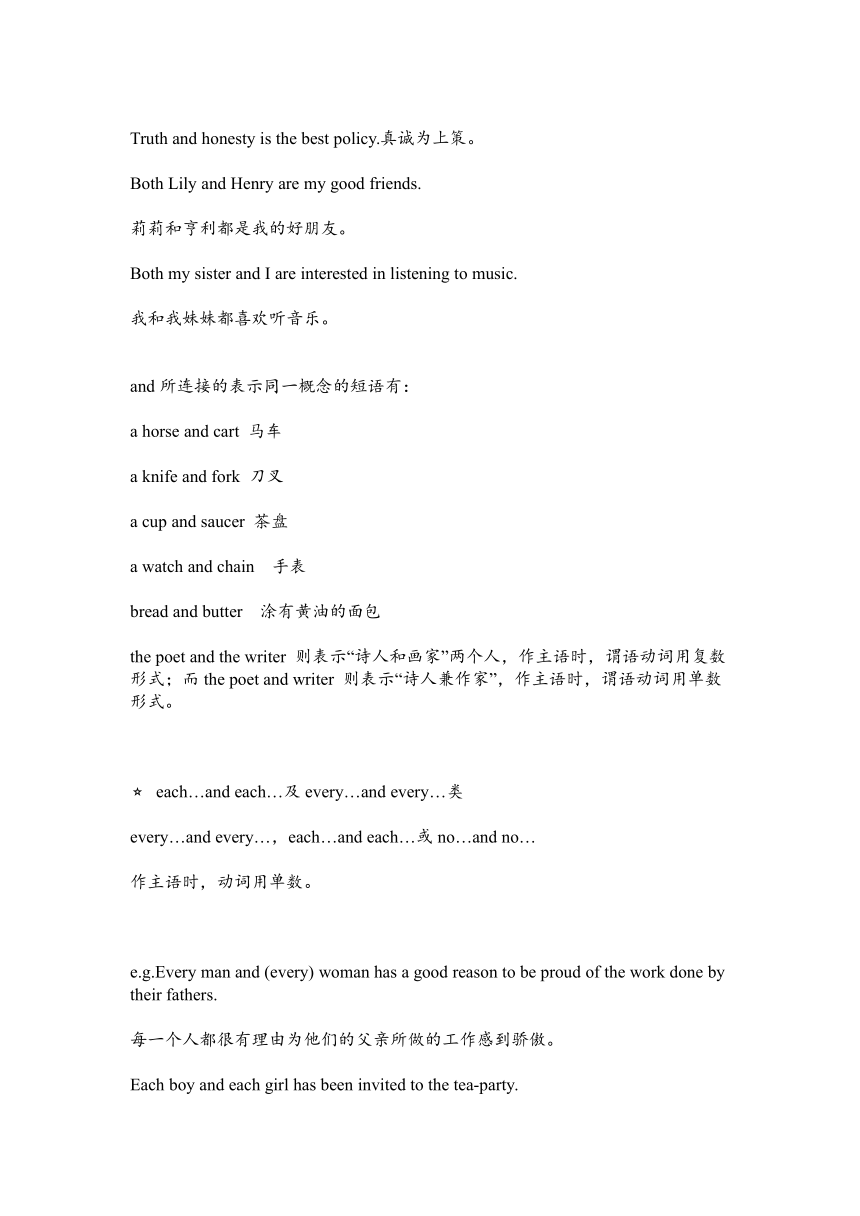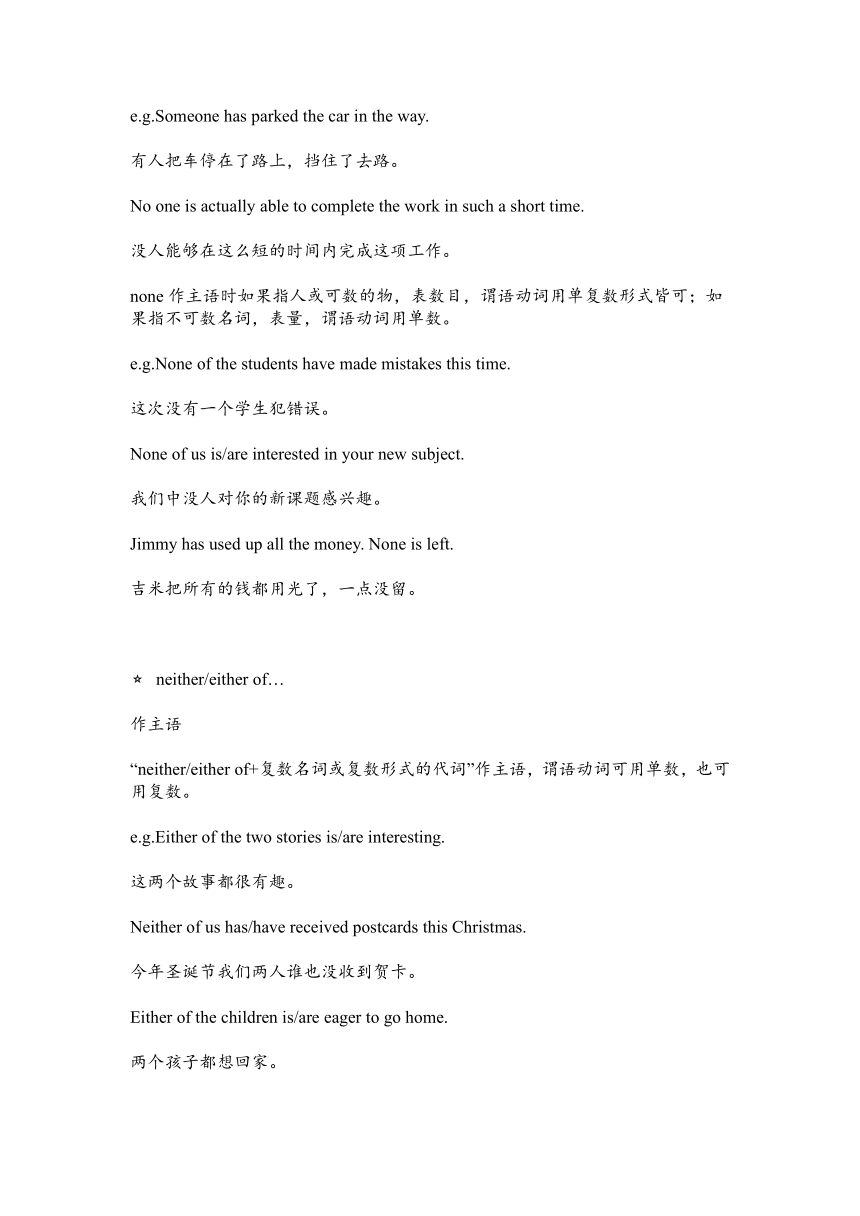2024年人教版中考英语语法复习主谓一致讲义
文档属性
| 名称 | 2024年人教版中考英语语法复习主谓一致讲义 |  | |
| 格式 | docx | ||
| 文件大小 | 36.6KB | ||
| 资源类型 | 教案 | ||
| 版本资源 | 人教新目标(Go for it)版 | ||
| 科目 | 英语 | ||
| 更新时间 | 2024-04-03 14:40:00 | ||
图片预览





文档简介
主谓一致
含义:主谓一致指的是句子的谓语动词与其主语在数上必须保持一致,句子的主语是第三人称单数,其谓语动词须用第三人称单数,主语是复数,则谓语动词用复数形式。
原则:英语中的主谓一致主要遵循三个原则:
意义一致原则
语法一致原则
邻近原则
语法一致原则
主语和谓语通常是从语法形式上取得一致,即主语是单数形式,谓语动词也采取第三人称单数形式;主语是复数形式,谓语动词也采取复数形式。
e.g.Mr. Black is a well-known scientist on AIDS.
布莱克先生是著名艾滋科学家。
These books are intended for children under nine years old.
这些书是专门为九岁以下的儿童设计的。
● 意义一致原则
所谓意义一致原则是指谓语动词的变化是以主语所表达的单、复数概念而定。
e.g.Three months has passed since you left.
你已离开三个月了。(three months表示单数概念。)
The professor and writer is invited to many universities to deliver lectures.
这位教授兼作家被邀请到很多大学作报告。(教授与作家是同一个人,是单数。)
The old are very well taken care of in our city.
老年人在我们城市被照顾得很好。(the old指所有的老年人,为复数概念。)
● 邻近一致原则(就近原则)
邻近一致原则是指谓语动词的变化以靠近谓语动词的主语部分而定。
e.g.Neither his parents nor he himself is a bank clerk.
他父母和他本人都不是银行职员。(根据靠近谓语的主语he而定。)
Not Jack but his parents are to blame for the home accident.
不是杰克而是他父母应为这个家庭事故受到责备。
(根据靠近谓语的主语his parents而定。)
主谓一致的各种情形
01并列结构作主语
并列结构作主语主要指主语是由并列的名词或名词短语构成,此时主要有如下几种情况。
and及both…and…类
一般来说,两个单数主语用and连接,表示两个不同的人或物时,动词用复数;但如果两个并列的单数主语在意义上指同一人、同一事物或同一概念,则动词须用单数。
e.g.Her teacher and her friend are in the sitting-room.
她的老师和她的朋友都在客厅里。
A smile and handshake show welcome.
微笑和握手表示欢迎。
Bread and butter is healthful food.
涂有黄油的面包是一种有益于健康的食物。
The poet and writer has produced many works.
这个诗人兼作家写出了很多作品。
Truth and honesty is the best policy.真诚为上策。
Both Lily and Henry are my good friends.
莉莉和亨利都是我的好朋友。
Both my sister and I are interested in listening to music.
我和我妹妹都喜欢听音乐。
and所连接的表示同一概念的短语有:
a horse and cart 马车
a knife and fork 刀叉
a cup and saucer 茶盘
a watch and chain 手表
bread and butter 涂有黄油的面包
the poet and the writer 则表示“诗人和画家”两个人,作主语时,谓语动词用复数形式;而the poet and writer 则表示“诗人兼作家”,作主语时,谓语动词用单数形式。
each…and each…及every…and every…类
every…and every…,each…and each…或no…and no…
作主语时,动词用单数。
e.g.Every man and (every) woman has a good reason to be proud of the work done by their fathers.
每一个人都很有理由为他们的父亲所做的工作感到骄傲。
Each boy and each girl has been invited to the tea-party.
每个男孩和每个女孩都被邀请参加茶话会了。
not…but…,not only…but also,or,either…or…,neither…nor...类
在由not…but…,not only…but (also),or,either…or,neither…nor等连接的并列主语中,谓语动词的人称和数应该和邻近它的主语相一致。
e.g.Tom or you are to blame.
应该怪汤姆或你。
Was he or you able to persuade her
是你还是他劝服了她
Not you but I am to blame for the mistake.
不是你而是我该为此错误而受到责备。
Not only I but also my parents are fond of traveling around.
不仅我而且我父母也喜欢到处旅游。
Neither you nor I am fit for the work.
你和我都不适合这个工作。
Are neither you nor I fit for the work
你和我都不适合这个工作吗
02不定代词作主语
不定代词either,neither,each,one,the other,another,someone,somebody,something,anyone,anybody,anything,everyone,everybody,everything,nobody,no one,nothing等
作主语时,谓语动词常用单数。
e.g.Someone has parked the car in the way.
有人把车停在了路上,挡住了去路。
No one is actually able to complete the work in such a short time.
没人能够在这么短的时间内完成这项工作。
none作主语时如果指人或可数的物,表数目,谓语动词用单复数形式皆可;如果指不可数名词,表量,谓语动词用单数。
e.g.None of the students have made mistakes this time.
这次没有一个学生犯错误。
None of us is/are interested in your new subject.
我们中没人对你的新课题感兴趣。
Jimmy has used up all the money. None is left.
吉米把所有的钱都用光了,一点没留。
neither/either of…
作主语
“neither/either of+复数名词或复数形式的代词”作主语,谓语动词可用单数,也可用复数。
e.g.Either of the two stories is/are interesting.
这两个故事都很有趣。
Neither of us has/have received postcards this Christmas.
今年圣诞节我们两人谁也没收到贺卡。
Either of the children is/are eager to go home.
两个孩子都想回家。
I don’t think either of them has/have married.
我想他们两个都没结婚。
Neither of the topics has/have been discussed so far.
到目前为止这两个话题都没有被讨论过。
the other two (…)等短语作主语
the other+基数词(+复数名词),another+基数词(+复数名词),both等作主语谓语动词用复数。
e.g.I keep only one apple for myself, and the other two are yours.
我只给自己留了一个苹果,另外两个给你。
Five people came to help, but another three were still needed.
已经有五个人来帮忙了,但我们还需要三个。
I’m very delighted that both are what we need.
我们很高兴两个都是我们所需要的。
all作主语
all作主语,指人时谓语动词用复数,指物时常用单数。
e.g.All are present besides the professor.
所有的人都出席,包括那位教授。
All is going on very well.
一切顺利。
each修饰的名词作主语
由each修饰的名词作主语,谓语动词用单数;each位于复数主语后或句尾作同位语,谓语动词仍与主语一致。
e.g.Each student has a walkman which helps them improve their listening.
每个学生都有一个随身听,这对提高他们的听力大有帮助。
Each of the class has been given a gift.
班里的每一个学生都得到了一份礼物。
They each have won a prize.
他们每人都得了奖。
such作主语
such作主语时谓语动词的单复数形式应根据其意义而定。
e.g.Such is Stephen Hawking,who has suffered a great deal but achieved so much.
这就是史蒂芬·霍金,遭受着巨大的痛苦而作出伟大成就的人。
Such are the difficulties that we are now faced with.
这就是我们现在所面临的困难。
Such as have plenty of money want more money.
那些有许多钱的人还想要更多的钱。
03形容词的名词化作主语
有些形容词加上the(如the old,the blind,the living,the dead,the rich,the poor,the young,the deaf(等)
用来表示一类人时,其意义为复数,谓语动词需用复数形式。表示一类物或抽象概念时,谓语动词用单数。
e.g.The old are taken good care of in our country.
在我们国家老人受到很好的照顾。
The poor are part of the people we help.
穷人是我们救助的一部分。
The injured have been sent to the hospital.
受伤人员已被送往医院。
The new is sure to replace the old.
新生事物一定会替代旧事物的。
The beautiful goes with the true and the good.
美总是和真、善相伴而生。
04复数形式、单数意义的名词作主语
以-ics结尾的学科名称的名词作主语时,谓语用单数。
e.g.Mathematics is the science of numbers.
数学是数字的科学。
Politics is often a topic for discussion among us.
政治是我们常常讨论的话题。
Physics is one of the hardest subjects for a middle school student.
物理是中学生感到最难的科目之一。
注意:以-ics结尾的表示学科名称的名词作主语时,若改变词义表示学科能力时,则用复数形式。
e.g.Her mathematics are weak.
她的数学很差。
形式上是复数形式的专有名词作主语
专有名词如国名、人名、书名、组织机构等作主语,形式上虽然是复数,但谓语动词还是要用单数。
e.g.The United Nations was founded in 1945.
联合固是1945年建立的。
The United States is in North America.
美国位于北美洲。
The New York Times has a wide circulation.
《纽约时报》有很广的销路。
以-s结尾的海峡、山脉、群岛等名词作主语,谓语动词常用复数形式。
e.g.The Straits of Gibraltar haven’t lost their strategical importance.
直布罗陀海峡尚未丧失其战略上的重要地位。
The Himalayas extend along the border of India and China.
喜马拉雅山脉沿着中印边境一直延伸。
表示时间、距离、金额、重量等的复数名词作主语,通常看作整体,谓语用单数。
e.g.Two hours is a long time to take over a coffee.
用两个小时喝杯咖啡的时间足够长了。
Ten pounds was missing from the till.
钱柜里的钱丢了10镑。
Six hundred miles is a long distance.
六百英里是一段很长的距离。
05集体名词作主语
谓语动词只能用复数的情况:有些集体名词,如people,cattle,police等形式上是单数,但意义上是复数,谓语动词需用复数。
e.g.Traffic police are always very busy, especially at busy streets.
交通警察总是十分忙碌,特别是在繁忙的街道。
People read for pleasure during their spare time.
人们在业余时间读书自娱。
谓语动词单复数皆可的情况
集体名词,如audience(观众),army(军队),class(班级),crew(船员),company(公司),crowd(人群),enemy(敌人),family(家庭),group(团,组),government(政府),public(公众),population(人口),team(队员)等作主语时,若视为一个整体看待,谓语动词用单数;若着眼于组成该集体的每个成员时,谓语动词则用复数。
e.g.His family was poor and he used to sit in the family garage and draw pictures.
他家很穷,他常常坐在他家的车库里画画。
My family are going on a trip this summer.
我们全家今年夏天要出外旅行。
The population in China is very large and 80% of the population live in rural areas.
中国人口很多,其中80%的人口在农村。
表示国家、人民的名词作主语的情况
有些以-sh,-ese,-ch结尾的表示国家、民族的形容词与the连用时表示复数含义,谓语动词用复数。
e.g.The English like to be with their families at Christmas.
英国人喜欢在圣诞节与家人团聚。
The Chinese are a hard-working people.
中华民族是一个勤劳的民族。
The French are fond of champagne.
法国人喜欢香槟酒。
06含有修饰语的名词作主语
含有量词的名词作主语
①量词修饰由两个对应部分组成的名词
一些由两个对应部分组成一体的复数名词,如trousers(裤子),pants(短裤),glasses(眼镜),scissors(剪刀)等作主语,前面若无a pair of,a suit of,a set of,a series of等这类的单位词,通常视为复数,谓语动词用复数。若带有单位词,则由单位词的单复数决定谓语动词的单复数形式。
e.g.My blue trousers have worn out.
我的蓝裤子已经穿破了。
This pair of glasses is very expensive.
这幅眼镜很贵。
The two pairs of scissors are Hangzhou-made.
这两把剪刀都是杭州制造的。
Two pieces of good news have been published on today’s evening paper.
今天的晚报报道了两条好消息。
②特殊量词修饰普通名词
含有像pile(堆),mountain(山),row(排),mass(很多),cup(杯),basket(篮),box(箱),pack(包),packet(小包)等词修饰的短语作主语,谓语动词根据修饰语的单复数形式而定。
e.g.Piles of rubbish have not only blocked the way, but polluted the air as well.
成堆的垃圾不仅阻塞了道路,而且污染了环境。
A row of willows is lined on one side of the river.
河的一岸长着一排柳树。
Masses of work are to be done to welcome the new year.
为了迎接新年,我们还有很多活要干。
A packet of letters needs mailing.
一包信需要寄出。
③ a group of和a couple of修饰复数名词,谓语动词用复数。
e.g.A group of boys and girls are dancing to welcome Children’s Day.
一群儿童在跳舞迎接儿童节。
A couple of days have passed since we parted.
我们分手已经有几天了。
④ a number of,the number of短语修饰名词作主语
a number of意为“许多”,修饰可数名词复数时谓语一般也用复数;the number of意思为“……的数目”,作主语时,谓语用单数。
e.g.A number of the other plants were found in America.
在美洲还发现了许多别的作物。
The number of people who travel by plane in China is larger than ever before.
在中国乘飞机旅行的人数比以往多了。
⑤ several等词或其修饰的名词作主语
只修饰可数名词的量词several,a few,quite a few,a great many (of…)作主语或其修饰的名词作主语,谓语动词都用复数形式。
e.g.Usually few regard their work as a pleasure.
通常很少有人把工作当成一种乐趣。
We’ve gathered varieties of books and a great many are to be sent to primary schools in the west of China.
我们已经募捐了很多书,很多即将送到西部的小学。
Several of us are determined to remain in the city after graduation.
我们中有一些人决定在毕业后留在城市。
⑥ some等词或其修饰的名词作主语
some,plenty of,a lot(of),lots(of)等词既可修饰或指代可数名词,又可修饰或指代不可数名词,其谓语的形式应根据所修饰词而定。
e.g.A lot of students are coming to the meeting.
很多学生要来参加这次会议。
A lot of work is to be done to prepare for the conference.
为了准备会议,还有很多工作要做。
a quantity (of), (large) quantities (of)作主语或其修饰的名词作主语,其谓语动词应根据quantity的单复数形式而定。
e.g.Quantities of money are needed to equip the school.
学校安装设备需要很多钱。
A quantity of story books has been bought for the children.
为儿童买了大量的故事书。
⑦ a great/good deal (of),a little,quite a little,a large amount (of)等修饰不可数名词的量词作主语或其修饰的名词作主语,其谓语动词只用单数形式。
e.g.A great deal of time was wasted playing but ought to have been fully used.
很多时间在玩耍中浪费掉了,但应该好好利用的。
A large amount of medicine is needed in the stricken area.
灾区需要大量的药品。
⑧ more(…) than one修饰的名词作主语
“more than one+单数名词”尽管意义上是复数,但因中心词是单数形式,谓语动词也须用单数。在“more+复数名词+than one”结构之后,谓语动词常用复数。
e.g.More than one person was injured in the accident.
不止一人在这次事故中受伤。
More than one way has been tried to stop noise pollution.
已经试过了很多方法来制止噪音污染。
More members than one are against the proposal.
反对这项提议的会员不止一个。
注意:
more than one hundred指复数或修饰可数名词复数作主语,谓语动词用复数形式。
e.g.More than one hundred children have joined this year’s summer camp.
100多个孩子参加了今年的夏令营。
⑨ many a修饰的名词作主语
“many a+单数名词”作主语,尽管意义上是复数,但因中心词是单数形式,谓语动词也须用单数。
e.g.Many a scientist has been trying to research into the SARS bacterin.
许多科学家正在研究非典疫苗。
⑩ one or two,a… or two修饰的名词作主语
one or two后接复数名词,谓语要用复数,但在“a/an+单数名词+or two”结构之后,谓语却常用单数。
e.g.One or two days are enough for this work.
A day or two is enough for this work.
干这活一两天就够了。
the rest (of…)等作主语
the rest (of…),the remaining,part (of…),one half (of…)等词或短语或它们所修饰的名词或代词作主语,其谓语动词应根据所表达的意义而定。
e.g.Many people present at the meeting were from the US, many from the UK and the rest were from China.
出席这次会议的很多人来自美国,很多来自英国,其他的来自中国。
The first part of the vacation was frustrating, but the rest of it was exciting.
假期的前半部分非常令人失望,但剩下的部分非常令人兴奋。
The first part of the lecture was vivid but the remaining was dull.
讲座的前半部分很生动,剩下的部分却非常枯燥。
Part of his story was not true.
他讲的故事有一部分不是真的。
Part of the foreign teachers in our school are from Canada.
我们学校的部分外籍教师来自加拿大。
百分数、分数及其他比例词或其修饰的名词作主语
“分数/百分数+of+名词”结构作主语:当“分数/百分数+of+名词”结构作主语时,一般应根据of后的名词的单复数决定谓语动词的单复数。
e.g.50% of the land is now suitable to grow plants.
百分之五十的土地现在适合种庄稼。
20% of the people in the city object to the price for running water going up.
这个城市中百分之二十的人反对自来水价格上调。
This is because two thirds of the earth's surface is made up of vast oceans.
这是因为地球表面的2/3是由广阔的海洋构成的。
Two thirds of these tasks have been completed.
这些任务已完成了三分之二。
“one and a half+复数可数名词”作主语,谓语动词一般用单数。
e.g.One and a half days is all I can spare.
我只能抽出一天半的时间。
One and a half apples is a good meal for the child.
一个半苹果对这个小孩来说是一顿美餐。
“one in+基数词…”作主语:一般情况下,“one in+基数词”或其修饰的名词作主语,谓语动词用单数形式。
e.g.It is reported that in this area one in four people suffers from lung cancer.
据报道此地区有四分之一的人患有肺癌。
07非谓语形式、从句作主语
非谓语形式作主语
①单独的不定式、动词的-ing形式作主语,谓语动词一般用单数形式。
e.g.To prevent the air from being polluted is what we’re now researching.
阻止空气污染是我们正在研究的课题。
Persuading him to join us seems really hard.
劝他加入我们似乎很难。
②由连接词连接的多个非谓语动词作主语
如果多个非谓语动词连在一起表达同一概念,谓语动词用单数形式;如果表达不同概念,谓语动词用复数。
e.g.To go to bed early and to rise early is a good habit.
早睡早起是好习惯。
To work and to live are two different things but they are always together.
工作和生活是两件不同的事情,但它们永远相伴。
从句作主语
that,what,who,which,when,where,why,whatever,whoever,whichever,whenever,wherever等引导的从句作主语或单独引导疑问句时,应根据概念一致原则决定谓语动词的数。
e.g.That Jack has gone abroad makes us all surprised.
杰克出国去了使我们都很惊讶。
Who is Abraham Lincoln
亚伯拉罕·林肯是谁
Who are talking with each other
谁正在谈话
What he says and acts does not concern me.
他的言行与我无关。(这里的says and acts笼统指人的行为。)
What he says and acts do not agree.
他的言行不一致。(指他说的话和他做的事不一致。)
Whichever is yours
究竟哪一个是你的
Which are yours
哪一些是你的
08
算式中的主谓一致
两数相加、相乘:此时谓语动词可用单数也可用复数形式。
e.g. Fifteen and five is/ are / makes/ make/ equals/ equal/ is equal to/ are equal to twenty.
15加5等于20。
Five times six is/ are/ makes/ make/ equals/ equal/ is equal to/are equal to thirty.
5乘以6等于30。
两数相减、相除:此时谓语动词用单数。
e.g.15 minus 5 is/ leaves/ makes/ is equal to 10.
15减去5等于10。
Fifteen divided by 5 is/ makes/ equals/ is equal to 3.
15除以5等于3。
09
There/Here引起主语的主谓一致
句子是由there,here引起且主语又不止一个时,谓语通常和最邻近的主语保持一致。
e.g.There is a lake and some hills around it.
那里被一个湖泊和几座小山环绕着。
There are several grammar mistakes in your composition.
你的作文中出现了几个语法错误。
Here goes the song again.
又唱起了这首歌。
含义:主谓一致指的是句子的谓语动词与其主语在数上必须保持一致,句子的主语是第三人称单数,其谓语动词须用第三人称单数,主语是复数,则谓语动词用复数形式。
原则:英语中的主谓一致主要遵循三个原则:
意义一致原则
语法一致原则
邻近原则
语法一致原则
主语和谓语通常是从语法形式上取得一致,即主语是单数形式,谓语动词也采取第三人称单数形式;主语是复数形式,谓语动词也采取复数形式。
e.g.Mr. Black is a well-known scientist on AIDS.
布莱克先生是著名艾滋科学家。
These books are intended for children under nine years old.
这些书是专门为九岁以下的儿童设计的。
● 意义一致原则
所谓意义一致原则是指谓语动词的变化是以主语所表达的单、复数概念而定。
e.g.Three months has passed since you left.
你已离开三个月了。(three months表示单数概念。)
The professor and writer is invited to many universities to deliver lectures.
这位教授兼作家被邀请到很多大学作报告。(教授与作家是同一个人,是单数。)
The old are very well taken care of in our city.
老年人在我们城市被照顾得很好。(the old指所有的老年人,为复数概念。)
● 邻近一致原则(就近原则)
邻近一致原则是指谓语动词的变化以靠近谓语动词的主语部分而定。
e.g.Neither his parents nor he himself is a bank clerk.
他父母和他本人都不是银行职员。(根据靠近谓语的主语he而定。)
Not Jack but his parents are to blame for the home accident.
不是杰克而是他父母应为这个家庭事故受到责备。
(根据靠近谓语的主语his parents而定。)
主谓一致的各种情形
01并列结构作主语
并列结构作主语主要指主语是由并列的名词或名词短语构成,此时主要有如下几种情况。
and及both…and…类
一般来说,两个单数主语用and连接,表示两个不同的人或物时,动词用复数;但如果两个并列的单数主语在意义上指同一人、同一事物或同一概念,则动词须用单数。
e.g.Her teacher and her friend are in the sitting-room.
她的老师和她的朋友都在客厅里。
A smile and handshake show welcome.
微笑和握手表示欢迎。
Bread and butter is healthful food.
涂有黄油的面包是一种有益于健康的食物。
The poet and writer has produced many works.
这个诗人兼作家写出了很多作品。
Truth and honesty is the best policy.真诚为上策。
Both Lily and Henry are my good friends.
莉莉和亨利都是我的好朋友。
Both my sister and I are interested in listening to music.
我和我妹妹都喜欢听音乐。
and所连接的表示同一概念的短语有:
a horse and cart 马车
a knife and fork 刀叉
a cup and saucer 茶盘
a watch and chain 手表
bread and butter 涂有黄油的面包
the poet and the writer 则表示“诗人和画家”两个人,作主语时,谓语动词用复数形式;而the poet and writer 则表示“诗人兼作家”,作主语时,谓语动词用单数形式。
each…and each…及every…and every…类
every…and every…,each…and each…或no…and no…
作主语时,动词用单数。
e.g.Every man and (every) woman has a good reason to be proud of the work done by their fathers.
每一个人都很有理由为他们的父亲所做的工作感到骄傲。
Each boy and each girl has been invited to the tea-party.
每个男孩和每个女孩都被邀请参加茶话会了。
not…but…,not only…but also,or,either…or…,neither…nor...类
在由not…but…,not only…but (also),or,either…or,neither…nor等连接的并列主语中,谓语动词的人称和数应该和邻近它的主语相一致。
e.g.Tom or you are to blame.
应该怪汤姆或你。
Was he or you able to persuade her
是你还是他劝服了她
Not you but I am to blame for the mistake.
不是你而是我该为此错误而受到责备。
Not only I but also my parents are fond of traveling around.
不仅我而且我父母也喜欢到处旅游。
Neither you nor I am fit for the work.
你和我都不适合这个工作。
Are neither you nor I fit for the work
你和我都不适合这个工作吗
02不定代词作主语
不定代词either,neither,each,one,the other,another,someone,somebody,something,anyone,anybody,anything,everyone,everybody,everything,nobody,no one,nothing等
作主语时,谓语动词常用单数。
e.g.Someone has parked the car in the way.
有人把车停在了路上,挡住了去路。
No one is actually able to complete the work in such a short time.
没人能够在这么短的时间内完成这项工作。
none作主语时如果指人或可数的物,表数目,谓语动词用单复数形式皆可;如果指不可数名词,表量,谓语动词用单数。
e.g.None of the students have made mistakes this time.
这次没有一个学生犯错误。
None of us is/are interested in your new subject.
我们中没人对你的新课题感兴趣。
Jimmy has used up all the money. None is left.
吉米把所有的钱都用光了,一点没留。
neither/either of…
作主语
“neither/either of+复数名词或复数形式的代词”作主语,谓语动词可用单数,也可用复数。
e.g.Either of the two stories is/are interesting.
这两个故事都很有趣。
Neither of us has/have received postcards this Christmas.
今年圣诞节我们两人谁也没收到贺卡。
Either of the children is/are eager to go home.
两个孩子都想回家。
I don’t think either of them has/have married.
我想他们两个都没结婚。
Neither of the topics has/have been discussed so far.
到目前为止这两个话题都没有被讨论过。
the other two (…)等短语作主语
the other+基数词(+复数名词),another+基数词(+复数名词),both等作主语谓语动词用复数。
e.g.I keep only one apple for myself, and the other two are yours.
我只给自己留了一个苹果,另外两个给你。
Five people came to help, but another three were still needed.
已经有五个人来帮忙了,但我们还需要三个。
I’m very delighted that both are what we need.
我们很高兴两个都是我们所需要的。
all作主语
all作主语,指人时谓语动词用复数,指物时常用单数。
e.g.All are present besides the professor.
所有的人都出席,包括那位教授。
All is going on very well.
一切顺利。
each修饰的名词作主语
由each修饰的名词作主语,谓语动词用单数;each位于复数主语后或句尾作同位语,谓语动词仍与主语一致。
e.g.Each student has a walkman which helps them improve their listening.
每个学生都有一个随身听,这对提高他们的听力大有帮助。
Each of the class has been given a gift.
班里的每一个学生都得到了一份礼物。
They each have won a prize.
他们每人都得了奖。
such作主语
such作主语时谓语动词的单复数形式应根据其意义而定。
e.g.Such is Stephen Hawking,who has suffered a great deal but achieved so much.
这就是史蒂芬·霍金,遭受着巨大的痛苦而作出伟大成就的人。
Such are the difficulties that we are now faced with.
这就是我们现在所面临的困难。
Such as have plenty of money want more money.
那些有许多钱的人还想要更多的钱。
03形容词的名词化作主语
有些形容词加上the(如the old,the blind,the living,the dead,the rich,the poor,the young,the deaf(等)
用来表示一类人时,其意义为复数,谓语动词需用复数形式。表示一类物或抽象概念时,谓语动词用单数。
e.g.The old are taken good care of in our country.
在我们国家老人受到很好的照顾。
The poor are part of the people we help.
穷人是我们救助的一部分。
The injured have been sent to the hospital.
受伤人员已被送往医院。
The new is sure to replace the old.
新生事物一定会替代旧事物的。
The beautiful goes with the true and the good.
美总是和真、善相伴而生。
04复数形式、单数意义的名词作主语
以-ics结尾的学科名称的名词作主语时,谓语用单数。
e.g.Mathematics is the science of numbers.
数学是数字的科学。
Politics is often a topic for discussion among us.
政治是我们常常讨论的话题。
Physics is one of the hardest subjects for a middle school student.
物理是中学生感到最难的科目之一。
注意:以-ics结尾的表示学科名称的名词作主语时,若改变词义表示学科能力时,则用复数形式。
e.g.Her mathematics are weak.
她的数学很差。
形式上是复数形式的专有名词作主语
专有名词如国名、人名、书名、组织机构等作主语,形式上虽然是复数,但谓语动词还是要用单数。
e.g.The United Nations was founded in 1945.
联合固是1945年建立的。
The United States is in North America.
美国位于北美洲。
The New York Times has a wide circulation.
《纽约时报》有很广的销路。
以-s结尾的海峡、山脉、群岛等名词作主语,谓语动词常用复数形式。
e.g.The Straits of Gibraltar haven’t lost their strategical importance.
直布罗陀海峡尚未丧失其战略上的重要地位。
The Himalayas extend along the border of India and China.
喜马拉雅山脉沿着中印边境一直延伸。
表示时间、距离、金额、重量等的复数名词作主语,通常看作整体,谓语用单数。
e.g.Two hours is a long time to take over a coffee.
用两个小时喝杯咖啡的时间足够长了。
Ten pounds was missing from the till.
钱柜里的钱丢了10镑。
Six hundred miles is a long distance.
六百英里是一段很长的距离。
05集体名词作主语
谓语动词只能用复数的情况:有些集体名词,如people,cattle,police等形式上是单数,但意义上是复数,谓语动词需用复数。
e.g.Traffic police are always very busy, especially at busy streets.
交通警察总是十分忙碌,特别是在繁忙的街道。
People read for pleasure during their spare time.
人们在业余时间读书自娱。
谓语动词单复数皆可的情况
集体名词,如audience(观众),army(军队),class(班级),crew(船员),company(公司),crowd(人群),enemy(敌人),family(家庭),group(团,组),government(政府),public(公众),population(人口),team(队员)等作主语时,若视为一个整体看待,谓语动词用单数;若着眼于组成该集体的每个成员时,谓语动词则用复数。
e.g.His family was poor and he used to sit in the family garage and draw pictures.
他家很穷,他常常坐在他家的车库里画画。
My family are going on a trip this summer.
我们全家今年夏天要出外旅行。
The population in China is very large and 80% of the population live in rural areas.
中国人口很多,其中80%的人口在农村。
表示国家、人民的名词作主语的情况
有些以-sh,-ese,-ch结尾的表示国家、民族的形容词与the连用时表示复数含义,谓语动词用复数。
e.g.The English like to be with their families at Christmas.
英国人喜欢在圣诞节与家人团聚。
The Chinese are a hard-working people.
中华民族是一个勤劳的民族。
The French are fond of champagne.
法国人喜欢香槟酒。
06含有修饰语的名词作主语
含有量词的名词作主语
①量词修饰由两个对应部分组成的名词
一些由两个对应部分组成一体的复数名词,如trousers(裤子),pants(短裤),glasses(眼镜),scissors(剪刀)等作主语,前面若无a pair of,a suit of,a set of,a series of等这类的单位词,通常视为复数,谓语动词用复数。若带有单位词,则由单位词的单复数决定谓语动词的单复数形式。
e.g.My blue trousers have worn out.
我的蓝裤子已经穿破了。
This pair of glasses is very expensive.
这幅眼镜很贵。
The two pairs of scissors are Hangzhou-made.
这两把剪刀都是杭州制造的。
Two pieces of good news have been published on today’s evening paper.
今天的晚报报道了两条好消息。
②特殊量词修饰普通名词
含有像pile(堆),mountain(山),row(排),mass(很多),cup(杯),basket(篮),box(箱),pack(包),packet(小包)等词修饰的短语作主语,谓语动词根据修饰语的单复数形式而定。
e.g.Piles of rubbish have not only blocked the way, but polluted the air as well.
成堆的垃圾不仅阻塞了道路,而且污染了环境。
A row of willows is lined on one side of the river.
河的一岸长着一排柳树。
Masses of work are to be done to welcome the new year.
为了迎接新年,我们还有很多活要干。
A packet of letters needs mailing.
一包信需要寄出。
③ a group of和a couple of修饰复数名词,谓语动词用复数。
e.g.A group of boys and girls are dancing to welcome Children’s Day.
一群儿童在跳舞迎接儿童节。
A couple of days have passed since we parted.
我们分手已经有几天了。
④ a number of,the number of短语修饰名词作主语
a number of意为“许多”,修饰可数名词复数时谓语一般也用复数;the number of意思为“……的数目”,作主语时,谓语用单数。
e.g.A number of the other plants were found in America.
在美洲还发现了许多别的作物。
The number of people who travel by plane in China is larger than ever before.
在中国乘飞机旅行的人数比以往多了。
⑤ several等词或其修饰的名词作主语
只修饰可数名词的量词several,a few,quite a few,a great many (of…)作主语或其修饰的名词作主语,谓语动词都用复数形式。
e.g.Usually few regard their work as a pleasure.
通常很少有人把工作当成一种乐趣。
We’ve gathered varieties of books and a great many are to be sent to primary schools in the west of China.
我们已经募捐了很多书,很多即将送到西部的小学。
Several of us are determined to remain in the city after graduation.
我们中有一些人决定在毕业后留在城市。
⑥ some等词或其修饰的名词作主语
some,plenty of,a lot(of),lots(of)等词既可修饰或指代可数名词,又可修饰或指代不可数名词,其谓语的形式应根据所修饰词而定。
e.g.A lot of students are coming to the meeting.
很多学生要来参加这次会议。
A lot of work is to be done to prepare for the conference.
为了准备会议,还有很多工作要做。
a quantity (of), (large) quantities (of)作主语或其修饰的名词作主语,其谓语动词应根据quantity的单复数形式而定。
e.g.Quantities of money are needed to equip the school.
学校安装设备需要很多钱。
A quantity of story books has been bought for the children.
为儿童买了大量的故事书。
⑦ a great/good deal (of),a little,quite a little,a large amount (of)等修饰不可数名词的量词作主语或其修饰的名词作主语,其谓语动词只用单数形式。
e.g.A great deal of time was wasted playing but ought to have been fully used.
很多时间在玩耍中浪费掉了,但应该好好利用的。
A large amount of medicine is needed in the stricken area.
灾区需要大量的药品。
⑧ more(…) than one修饰的名词作主语
“more than one+单数名词”尽管意义上是复数,但因中心词是单数形式,谓语动词也须用单数。在“more+复数名词+than one”结构之后,谓语动词常用复数。
e.g.More than one person was injured in the accident.
不止一人在这次事故中受伤。
More than one way has been tried to stop noise pollution.
已经试过了很多方法来制止噪音污染。
More members than one are against the proposal.
反对这项提议的会员不止一个。
注意:
more than one hundred指复数或修饰可数名词复数作主语,谓语动词用复数形式。
e.g.More than one hundred children have joined this year’s summer camp.
100多个孩子参加了今年的夏令营。
⑨ many a修饰的名词作主语
“many a+单数名词”作主语,尽管意义上是复数,但因中心词是单数形式,谓语动词也须用单数。
e.g.Many a scientist has been trying to research into the SARS bacterin.
许多科学家正在研究非典疫苗。
⑩ one or two,a… or two修饰的名词作主语
one or two后接复数名词,谓语要用复数,但在“a/an+单数名词+or two”结构之后,谓语却常用单数。
e.g.One or two days are enough for this work.
A day or two is enough for this work.
干这活一两天就够了。
the rest (of…)等作主语
the rest (of…),the remaining,part (of…),one half (of…)等词或短语或它们所修饰的名词或代词作主语,其谓语动词应根据所表达的意义而定。
e.g.Many people present at the meeting were from the US, many from the UK and the rest were from China.
出席这次会议的很多人来自美国,很多来自英国,其他的来自中国。
The first part of the vacation was frustrating, but the rest of it was exciting.
假期的前半部分非常令人失望,但剩下的部分非常令人兴奋。
The first part of the lecture was vivid but the remaining was dull.
讲座的前半部分很生动,剩下的部分却非常枯燥。
Part of his story was not true.
他讲的故事有一部分不是真的。
Part of the foreign teachers in our school are from Canada.
我们学校的部分外籍教师来自加拿大。
百分数、分数及其他比例词或其修饰的名词作主语
“分数/百分数+of+名词”结构作主语:当“分数/百分数+of+名词”结构作主语时,一般应根据of后的名词的单复数决定谓语动词的单复数。
e.g.50% of the land is now suitable to grow plants.
百分之五十的土地现在适合种庄稼。
20% of the people in the city object to the price for running water going up.
这个城市中百分之二十的人反对自来水价格上调。
This is because two thirds of the earth's surface is made up of vast oceans.
这是因为地球表面的2/3是由广阔的海洋构成的。
Two thirds of these tasks have been completed.
这些任务已完成了三分之二。
“one and a half+复数可数名词”作主语,谓语动词一般用单数。
e.g.One and a half days is all I can spare.
我只能抽出一天半的时间。
One and a half apples is a good meal for the child.
一个半苹果对这个小孩来说是一顿美餐。
“one in+基数词…”作主语:一般情况下,“one in+基数词”或其修饰的名词作主语,谓语动词用单数形式。
e.g.It is reported that in this area one in four people suffers from lung cancer.
据报道此地区有四分之一的人患有肺癌。
07非谓语形式、从句作主语
非谓语形式作主语
①单独的不定式、动词的-ing形式作主语,谓语动词一般用单数形式。
e.g.To prevent the air from being polluted is what we’re now researching.
阻止空气污染是我们正在研究的课题。
Persuading him to join us seems really hard.
劝他加入我们似乎很难。
②由连接词连接的多个非谓语动词作主语
如果多个非谓语动词连在一起表达同一概念,谓语动词用单数形式;如果表达不同概念,谓语动词用复数。
e.g.To go to bed early and to rise early is a good habit.
早睡早起是好习惯。
To work and to live are two different things but they are always together.
工作和生活是两件不同的事情,但它们永远相伴。
从句作主语
that,what,who,which,when,where,why,whatever,whoever,whichever,whenever,wherever等引导的从句作主语或单独引导疑问句时,应根据概念一致原则决定谓语动词的数。
e.g.That Jack has gone abroad makes us all surprised.
杰克出国去了使我们都很惊讶。
Who is Abraham Lincoln
亚伯拉罕·林肯是谁
Who are talking with each other
谁正在谈话
What he says and acts does not concern me.
他的言行与我无关。(这里的says and acts笼统指人的行为。)
What he says and acts do not agree.
他的言行不一致。(指他说的话和他做的事不一致。)
Whichever is yours
究竟哪一个是你的
Which are yours
哪一些是你的
08
算式中的主谓一致
两数相加、相乘:此时谓语动词可用单数也可用复数形式。
e.g. Fifteen and five is/ are / makes/ make/ equals/ equal/ is equal to/ are equal to twenty.
15加5等于20。
Five times six is/ are/ makes/ make/ equals/ equal/ is equal to/are equal to thirty.
5乘以6等于30。
两数相减、相除:此时谓语动词用单数。
e.g.15 minus 5 is/ leaves/ makes/ is equal to 10.
15减去5等于10。
Fifteen divided by 5 is/ makes/ equals/ is equal to 3.
15除以5等于3。
09
There/Here引起主语的主谓一致
句子是由there,here引起且主语又不止一个时,谓语通常和最邻近的主语保持一致。
e.g.There is a lake and some hills around it.
那里被一个湖泊和几座小山环绕着。
There are several grammar mistakes in your composition.
你的作文中出现了几个语法错误。
Here goes the song again.
又唱起了这首歌。
